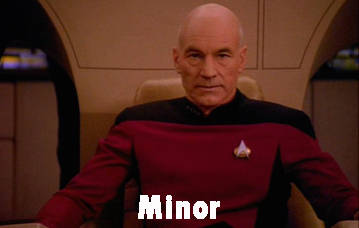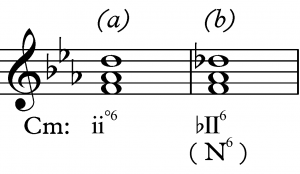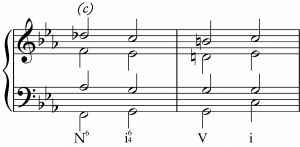
Below is the first part of my Write Like Mozart Week 5 Notes that I sent my students last year when we took the Write Like Mozart class together. The Write Like Mozart class is online again at the time of these posts. Each of these posts are timed to match the current week of that class.
In this installment, I discuss the chromatic substitutions for harmonies that were presented in the lectures: the Neapolitan, Augmented 6th, minor iv, ♭VI, and major I (Picardy third) chords.
This is the seventh post in this series.
Professor Edwards presents two key ideas during this week:
- Chromatic Harmony Substitutions
- Writing 2-Part Counterpoint
This post covers Chromatic Harmony Substitution. My next post will cover some notes on writing 2-part counterpoint.
Chromatic Substitutions
You might think of classifying the Chromatic Substitutions that Professor Edwards presents into two categories:
- The Weird Chords:
- Neapolitan 6th Chords
- Augmented 6th Chords
- The Easier Chords:
- Minor iv (when in a Major key)
- ♭VI (when in a Major key)
- Major I (when in a minor key)
I like to think of the “weird ones” as substitutions which turn melodic Major Seconds into Minor Seconds. For example …
Neapolitan Chords
This is a substitute for ii chord. In the key of C minor, the ii chord is D diminished (see Example (a)).
The D is eventually moving to C in a cadence. If the D is changed to a D♭, then the D (2nd scale degree) is that much closer to the C. (Example (b))
The Neapolitan Chord really shines when moving from a N6 to a i6-4 to a V. Then the D♭ can move to the C of the i6-4 chord and get that 1/2 step movement. (Example (c))
Note that the Neapolitan is a MAJOR chord always, on the ♭ 2 of the scale, and it is almost always in 1st inversion!
You do not need to have the neapolitan only in minor keys, but that perhaps is where it sounds smoothest.
Augmented 6th Chords
Professor Edwards claims that the Augmented 6th Chord is a substitution for the IV chord. Maybe, I’d say, but it feels very different to me. If you watch the video, you’ll see that he doesn’t seem quite convinced of this.
However, where there is a IV chord going to a V, you can probably put the Augmented 6th chord. It is definitely a pre-dominant chord.
The half step here comes from the 6th scale degree moving to the 5th scale degree AND the 4th scale degree moving to the 5th scale degree. It’s a double whammy – two whole step movements turned into two half steps! (Example (e))
In the key of C, the IV6 chord has three notes: an F, an A, and a C. In voice leading of an IV6 to a V chord, the F would usually move to G, and in the bass the A would move to the G. In an Augmented 6th chord, the A of the IV6 is now an A♭, and the F is now an F♯. Thus, both the F♯ and A♭ move to their respective G’s, by half step.
Every Augmented 6th chord has three things in common:
- ♭ 6 in the bass (i.e., the 6th note of the major scale is lowered a half step)
- ♯ 4 in an upper voice (the 4th note of the scale is raised a half step)
- The tonic is somewhere else in an upper voice
The name “Augmented 6th” comes from the interval of the ♭6 (A♭) in the bass and the ♯4 (F♯) above it — an interval of an augmented 6th. (Example (d))
There are three types of Augmented 6 chords:
- Italian, which has only those three notes mentioned above
- German, which adds the ♭3 (E♭) or #2 (D#), making the chord enharmonically equivalent to a dominant 7th chord. In other words, played by itself, it would sound like a Dominant 7th chord.
- French, which adds instead the 2nd scale degree (D)
I remember the names of each type of Augmented 6th chord this way:
- Italian food is known for its simplicity and elegance (think pasta dishes). Hence, the simplest of the Augmented 6th chords (just 3 notes) is the Italian.
- German food has a brashness and overtness to it (think Bratwurst, sauerbraten, sauerkraut…). The German Augmented 6th chord sounds like a Dominant 7th chord, and to me it is the most brash of the Augmented 6th chords.
- French food is full of subtleties and complexities. The French Augmented 6th chord, with its two major thirds placed a tritone apart, sounds to me the most pleasingly complex of the set.
While any of the Augmented 6th chords may go to a I 6-4, the German Aug 6 chord MUST ALWAYS GO TO A I 6-4 chord. Otherwise, the voice leading creates parallel fifths (E♭ → D, A♭ → G).
The German Augmented 6th may be spelled two different ways (example below), depending upon its voice leading. From example (d), the E♭ might be spelled as a D# if that voice moved to an E♮ instead of remaining on an E♭.
Minor iv when in a Major Key
This is a simple chord substitution. When the predominant scale is a major scale, you can use a minor iv (e.g., F minor for the key of C Major) instead of a major IV (e.g., F major). You’re borrowing the ♭6 (A♭) from the harmonic minor.
♭VI when in a Major key
This is another simple chord substitution. When in a major key, use a Major VI (e.g., A♭ major) instead of a minor vi (e.g., A minor), on the ♭6. You’re borrowing both the ♭6 (A♭) and the ♭3 (E♭) from the harmonic minor.
Modal differences between minor iv and♭VI substitution
Even though substituting the minor iv and the ♭VI involves borrowing chords from the parallel minor key, they offer different effects to the overall mode of the piece. Using a ♭VI effectively changes the momentary mode of the piece from major to harmonic minor. Every note in the harmonic minor has been accounted for. E.g., in the key of C Major, the E♭ and A♭ from the ♭VI effectively change the scale in the listener’s ear to:
C D E♭ F G A♭ B (C)
(Students of Marianne Ploger will be familiar with this concept from her discussions of “heptachords.”)
However, substituting a minor iv has only borrowed one note from the parallel harmonic minor: the ♭6. Thus, in the key of C Major, borrowing the ♭6 gives us the following scale within the listener’s ear:
C D E♮ F G A♭ B (C)
This is a “mixture” of the major and minor modes. In a way, the E♮ from the major mode competes with the A♭ from the minor mode. This results in a lovely juxtaposition of the two modes within the ear that is quite different from a purely major or a purely harmonic minor mode.
Major I when in a minor key
In the historical context of the Write Like Mozart course, this usually happens at the END of a cadence, on the last chord, when the prevailing key is a minor key.
To make this substitution, you will set up the cadence, and when you end, instead of ending on minor i, you raise the 3rd to create a major I. (Example (f)) This chord substitution, where the ♭3 is raised, is commonly known as the “Picardy Third.” For many, this sounds as a way to end on a “happy” note (pun intended) after a “dark” or “sad” feeling to the piece. To my ears, the Picardy Third requires careful consideration in its use to avoid sounding trite, but it can be an effective release of tension or intentional contrast in an otherwise dark setting.
In my next post, I will offer some notes to complement Professor Edwards discussion of two-part counterpoint.
But before closing … if you are a music geek who followed Star Trek …






So glad that Henry Flurry composes/writes like Mozart ! !